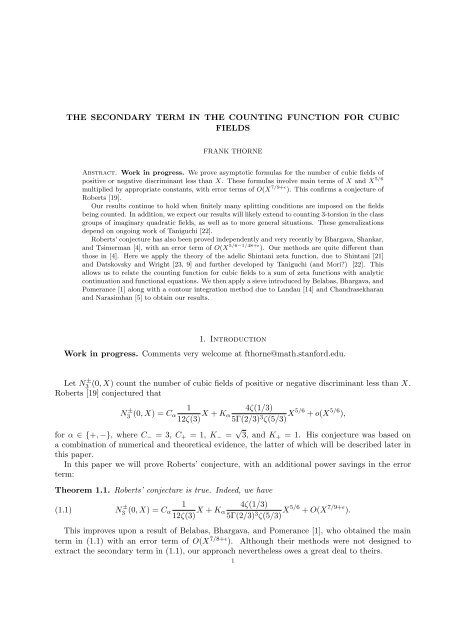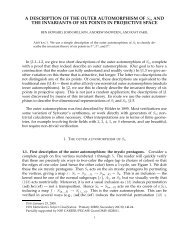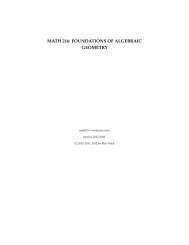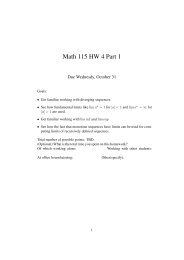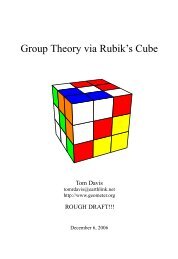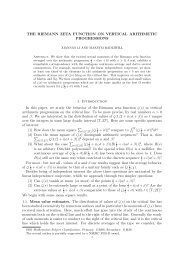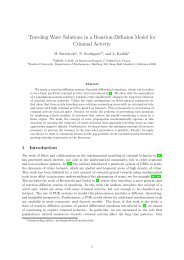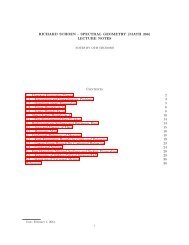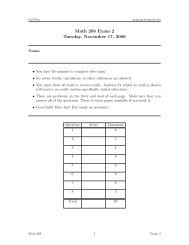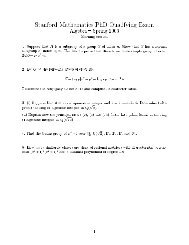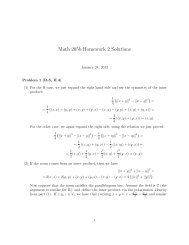THE SECONDARY TERM IN THE COUNTING FUNCTION FOR ...
THE SECONDARY TERM IN THE COUNTING FUNCTION FOR ...
THE SECONDARY TERM IN THE COUNTING FUNCTION FOR ...
Create successful ePaper yourself
Turn your PDF publications into a flip-book with our unique Google optimized e-Paper software.
<strong>THE</strong> <strong>SECONDARY</strong> <strong>TERM</strong> <strong>IN</strong> <strong>THE</strong> COUNT<strong>IN</strong>G <strong>FUNCTION</strong> <strong>FOR</strong> CUBIC<br />
FIELDS<br />
FRANK THORNE<br />
Abstract. Work in progress. We prove asymptotic formulas for the number of cubic fields of<br />
positive or negative discriminant less than X. These formulas involve main terms of X and X 5/6<br />
multiplied by appropriate constants, with error terms of O(X 7/9+ɛ ). This confirms a conjecture of<br />
Roberts [19].<br />
Our results continue to hold when finitely many splitting conditions are imposed on the fields<br />
being counted. In addition, we expect our results will likely extend to counting 3-torsion in the class<br />
groups of imaginary quadratic fields, as well as to more general situations. These generalizations<br />
depend on ongoing work of Taniguchi [22].<br />
Roberts’ conjecture has also been proved independently and very recently by Bhargava, Shankar,<br />
and Tsimerman [4], with an error term of O(X 5/6−1/48+ɛ ). Our methods are quite different than<br />
those in [4]. Here we apply the theory of the adelic Shintani zeta function, due to Shintani [21]<br />
and Datskovsky and Wright [23, 9] and further developed by Taniguchi (and Mori?) [22]. This<br />
allows us to relate the counting function for cubic fields to a sum of zeta functions with analytic<br />
continuation and functional equations. We then apply a sieve introduced by Belabas, Bhargava, and<br />
Pomerance [1] along with a contour integration method due to Landau [14] and Chandrasekharan<br />
and Narasimhan [5] to obtain our results.<br />
1. Introduction<br />
Work in progress. Comments very welcome at fthorne@math.stanford.edu.<br />
Let N 3 ± (0, X) count the number of cubic fields of positive or negative discriminant less than X.<br />
Roberts [19] conjectured that<br />
N 3 ± (0, X) = C 1<br />
α<br />
12ζ(3) X + K 4ζ(1/3)<br />
α<br />
5Γ(2/3) 3 ζ(5/3) X5/6 + o(X 5/6 ),<br />
for α ∈ {+, −}, where C − = 3, C + = 1, K − = √ 3, and K + = 1. His conjecture was based on<br />
a combination of numerical and theoretical evidence, the latter of which will be described later in<br />
this paper.<br />
In this paper we will prove Roberts’ conjecture, with an additional power savings in the error<br />
term:<br />
Theorem 1.1. Roberts’ conjecture is true. Indeed, we have<br />
(1.1) N 3 ± (0, X) = C 1<br />
α<br />
12ζ(3) X + K 4ζ(1/3)<br />
α<br />
5Γ(2/3) 3 ζ(5/3) X5/6 + O(X 7/9+ɛ ).<br />
This improves upon a result of Belabas, Bhargava, and Pomerance [1], who obtained the main<br />
term in (1.1) with an error term of O(X 7/8+ɛ ). Although their methods were not designed to<br />
extract the secondary term in (1.1), our approach nevertheless owes a great deal to theirs.<br />
1
2 FRANK THORNE<br />
Roberts’ conjecture has also been proved, with an error term of O(X 5/6−1/48+ɛ ), in independent<br />
(and extremely recent) work of Bhargava, Shankar, and Tsimerman [4]. Their proof is fundamentally<br />
geometric, and uses a “slicing and smoothing” technique to accurately count the number<br />
of points in fundamental domains for a certain group action to be described below. In contrast,<br />
our proof uses the analytic theory of adelic Shintani zeta functions, developed by Shintani [21],<br />
Datskovsky and Wright [23, 9], and Taniguchi [22]. As we summarize below, our proof proceeds by<br />
relating the count N 3 ± (0, X) to certain partial sums of zeta functions which enjoy analytic continuation<br />
and a functional equation. This allows us to estimate N 3 ± (0, X) in terms of contour integrals<br />
of these zeta functions.<br />
1.1. Generalizations and extensions. Our approach works in a fair amount of generality, and<br />
we also obtain (1.1) in the case of counting fields with a fixed, finite number of splitting conditions<br />
imposed. Moreover, we will be able to exactly specify the dependence of our error terms on the<br />
splitting conditions imposed.<br />
Our approach will almost certainly yield the analogue of (1.1) in the classically related problem<br />
of counting 3-torsion in imaginary quadratic fields, possibly with error O(X 9/11+ɛ ) instead of<br />
O(X 7/9+ɛ ). Moreover, we will be able to obtain the analogue of (1.1) in a fairly general setting,<br />
although we have not yet determined how general.<br />
We will describe all of this in more detail in a future version of this paper. These results depend<br />
on the properties of certain cubic Gauss sums, which are currently being studied by Taniguchi [22].<br />
In the case of cubic fields, Taniguchi has proved the needed properties already, and these are stated<br />
in Proposition 3.3. Taniguchi’s methods appear to work in general, and his results will presumably<br />
allow for the easy computation of the relevant bounds analogous to those appearing in Proposition<br />
3.3.<br />
In Section 5 we describe precisely how these generalizations will follow from any results proved<br />
by Taniguchi.<br />
1.2. The Davenport-Heilbronn and Delone-Faddeev correspondences. Our proof begins<br />
with the work of Davenport and Heilbronn [7], who established the main term in (1.1). Davenport<br />
and Heilbronn’s proof consists essentially of two parts. They begin by essentially showing a correspondence<br />
between cubic orders and certain binary cubic forms. They then showed that these<br />
orders were maximal if the corresponding cubic forms satisfied appropriate local conditions for each<br />
prime p. It then follows (nontrivially) that the count of cubic fields is given by the appropriate<br />
count of cubic forms multiplied by a certain Euler product, and this is the main term in (1.1).<br />
Remark. It will be of interest to describe a result of Hough, who obtained a power-saving error<br />
term in the Davenport-Heilbronn theorem for 3-torsion in quadratic fields, without reference to the<br />
Delone-Faddeev correspondence. Assuming we manage to prove the analogue of Roberts’ conjecture<br />
in this setting, we will do so there.<br />
We now describe Davenport and Heilbronn’s work in somewhat more detail; we recommend<br />
Bhargava’s paper [2] for a very enlightening account. The first part of the proof is the correspondence<br />
between cubic orders and cubic rings. This correspondence was also established by Delone<br />
and Faddeev [8], and in a more conceptual framework, so we will give Delone and Faddeev’s version<br />
of the correspondence.<br />
The Delone-Faddeev correspondence related cubic rings to integral binary cubic forms. A cubic<br />
ring, by definition, is a commutative ring with unit which is free of rank 3 as a Z-module. These<br />
include maximal orders of cubic fields, which we wish to count, as well as nonmaximal cubic orders<br />
and reducible rings, which we don’t wish to count.
The lattice of integral binary cubic forms is defined by<br />
COUNT<strong>IN</strong>G CUBIC FIELDS 3<br />
(1.2) V Z := {ax 3 + bx 2 y + cxy 2 + dy 3 : a, b, c, d ∈ Z},<br />
and there discriminant of such a cubic form is given by the usual equation<br />
(1.3) Disc(f) = b 2 c 2 − 4ac 3 − 4b 3 d − 27a 2 d 2 + 18abcd.<br />
Furthermore, there is a natural action of GL 2 (Z) on V Z , given by<br />
(1.4) (γ · f)(x, y) = 1 f((x, y) · γ).<br />
det γ<br />
We call a cubic form f irreducible if f(x, y) is irreducible as a polynomial over Q.<br />
The Delone-Faddeev correspondence, as extended by Gan, Gross, and Savin [12] to include the<br />
discriminant zero case, is the following:<br />
Theorem 1.2 ([8, 12]). There is a natural, discriminant-preserving bijection between the set of<br />
GL 2 (Z)-equivalence classes of integral binary cubic forms and the set of isomorphism classes of<br />
cubic rings. Furthermore, under this correspondence, irreducible cubic forms correspond to orders<br />
in cubic fields.<br />
This, then, gives one a way of counting cubic rings.<br />
The second part of Davenport and Heilbronn’s work consists of a maximality condition, imposed<br />
at all primes p.<br />
Definition 1.3 ([7, 2]). For a prime p, the set U p ⊂ V Z is defined to be the set of all cubic forms<br />
f satisfying the following equivalent conditions:<br />
• The cubic ring R(f) corresponding to f under the Delone-Faddeev correspondence is not<br />
contained in any other cubic ring with index divisible by p.<br />
• The cubic form f is not a multiple of p, and there is no GL 2 (Z)-transformation of f(x, y) =<br />
ax 3 + bx 2 y + cxy 2 + dy 2 such that a is a multiple of p 2 and b is a multiple of p.<br />
The equivalence above was proved by Davenport and Heilbronn, with a reformulation due to<br />
Bhargava. An irreducible cubic form f is maximal, and therefore corresponds to the maximal order<br />
of a cubic field, if belongs to U p for all primes p. Similarly, a reducible form f is maximal, and<br />
therefore corresponds to the maximal order of a lower order field, if it belongs to U p for all p. We<br />
note that membership in U p depends only on the coordinates of f modulo p 2 .<br />
1.3. The work of Belabas, Bhargava, and Pomerance. With this background taken care of,<br />
we may describe Belabas, Bhargava, and Pomerance’s proof [1]. They begin by observing that<br />
(1.5) N ± 3 (0, X) = ∑ q≥1<br />
µ(q)N ± (q, X),<br />
where N ± (q, X) counts the number of cubic orders of discriminant 0 < ±D < X, which are<br />
“nonmaximal at q”, i.e., which are not maximal at any prime dividing q.<br />
For large q, BBP prove the bound<br />
)<br />
N + (q, X) = O<br />
(X3 ω(q) /q 2<br />
via reasonably elementary methods. This bound is sufficiently good to truncate the infinite sum in<br />
[1] to a sum over q ≤ Q, with error ≪ X/Q 1−ɛ .<br />
For small q, BBP prove an asymptotic formula for N + (q, X) based essentially on counting lattice<br />
points. It follows from the equivalence in Definition 1.3 that the q-nonmaximality condition can
4 FRANK THORNE<br />
be detected by reducing cubic forms modulo q 2 , and accordingly forms in N + (q, X) have a density<br />
in the set of all cubic forms, which may be computed via a finite computation over Z/q 2 Z. BBP<br />
obtain power saving error terms for this estimate, and therefore are able to take the sum in [1] up<br />
to (X log X) 1/8 .<br />
1.4. Shintani zeta functions and the analytic approach. In this paper, we will improve upon<br />
BBP by adopting an analytic approach. In particular, we will apply Shintani’s theory of the zeta<br />
functions associated to the space of binary cubic forms. The (cubic) Shintani zeta functions 1 are<br />
defined by<br />
∑<br />
(1.6) ξ ± 1<br />
(s) :=<br />
|Stab(x)| |Disc(x)|−s ,<br />
x∈SL 2 (Z)\V Z<br />
where the sum ranges over elements of positive or negative discriminant respectively. Shintani<br />
proved [21] that these zeta functions enjoy analytic continuation and a functional equation, and<br />
therefore it follows that we may estimate partial sums of the coefficients using analytic methods<br />
due essentially to Landau [14]. And we see at once that these partial sums are closely related to<br />
(but not identical with) N ± (1, X).<br />
We may incorporate Davenport and Heilbronn’s conditions thanks to work of Datskovsky and<br />
Wright [23, 9]. They put Shintani’s zeta function on an adelic footing, and therefore established<br />
that Shintani’s construction is compatible with Davenport and Heilbronn’s maximality criteria.<br />
Landau’s analytic methods then give us an alternative way of estimating the quantities N ± (q, X)<br />
occurring in (1.5). In particular we naturally obtain secondary terms corresponding to poles of<br />
these zeta functions at s = 5/6, the residues of which are multiplicative in q.<br />
Datskovsky and Wright’s work was followed by work of Taniguchi [22], who explicitly calculated<br />
the functional equations and formulas for all the zeta functions of interest. For q > 1, the zeta<br />
functions are no longer even approximately self-dual, and the functional equations for these zeta<br />
functions involve certain cubic Gauss sums, i.e., character sums over (Z/q 2 Z) 4 . Taniguchi [22] (and<br />
Mori?)’s work includes a method to evaluate these sums, and they have evaluated them in all the<br />
cases of interest. In particular, Taniguchi’s results imply that these Gauss sums are not too large<br />
on average, a fact that is indispensable to our proof.<br />
General comments, to be added later: Describe how the rest of the proof fits together, and<br />
the structure of the paper. Describe my other work (on almost-prime discriminants) to be done<br />
later. Speculate on generalizations and interesting follow-up work (and describe which of this I’m<br />
doing personally). Also, review my choice of notation (q will always be squarefree; I have preferred<br />
ξ + and ξ − to ξ 1 and ξ 2 , and usage of the term “Shintani zeta functions” has precedent, but is not<br />
universal). Also mention that one may be able to replace epsilons throughout by logs, but this is<br />
not guaranteed.<br />
Also, a description of related and future work has been postponed to the next section (since I<br />
found it convenient to describe the Shintani zeta functions first), so either refer ahead or move it<br />
here.<br />
1 The use of the terminology “Shintani zeta function” for these zeta functions has some precedent, and we find<br />
it convenient to adopt it. However, we warn the reader that this terminology has also been applied to other zeta<br />
functions which are not directly related.<br />
Along the same lines, the functions ξ + and ξ − are usually denoted ξ 1 and ξ 2 in the literature, but we will need to<br />
introduce an additional numerical parameter later, and so we found this choice of notation to be clearer.
To be added after the referee report.<br />
COUNT<strong>IN</strong>G CUBIC FIELDS 5<br />
Acknowledgments<br />
2. q-nonmaximal Shintani zeta functions and their duals<br />
We recall that the Shintani zeta functions associated to the space of binary cubic forms are<br />
defined to be the Dirichlet series<br />
∑<br />
(2.1) ξ ± 1<br />
(s) :=<br />
|Stab(x)| |Disc(x)|−s ,<br />
x∈SL 2 (Z)\V Z<br />
where Stab(x) is the stabilizer of a point x in SL 2 (Z) (and always has order either 1 or 3). In<br />
this section we will recall the analytic theory of these functions, and introduce their q-nonmaximal<br />
analogues. In doing so we will draw upon work of Shintani [21], Datskovsky and Wright [23, 9],<br />
and Taniguchi (and Mori?) [22].<br />
The subject starts with the seminal work of Shintani [21], who proved that the series in (2.1)<br />
converge absolutely for R(s) > 1, and enjoy analytic continuation to all of C with poles only at<br />
s = 1 and s = 5/6, and satisfy the functional equation<br />
(2.2)<br />
(<br />
ξ + (1 − s)<br />
ξ − (1 − s)<br />
)<br />
(<br />
= Γ s − 1 ) (<br />
Γ(s) 2 Γ s + 1 )<br />
(<br />
2 −1 3 6s−2 π −4s sin 2πs sin πs<br />
×<br />
6<br />
6<br />
3 sin πs sin 2πs<br />
where the dual Shintani zeta functions are given by<br />
(2.3) ̂ξ± (s) :=<br />
∑<br />
x∈SL 2 (Z)\ V c Z<br />
1<br />
|Stab(x)| |Disc(x)|−s ,<br />
) ( ̂ξ+ q (s)<br />
̂ξ − q (s)<br />
where ̂V Z is the dual lattice to V Z , the lattice of integral binary cubic forms whose middle coefficients<br />
are divisible by 3:<br />
(2.4) V Z := {ax 3 + bx 2 y + cxy 2 + dy 3 : a, 1 3 b, 1 c, d ∈ Z},<br />
3<br />
Shintani’s theory has a variety of interesting consequences. One of them is that we may use<br />
analytic techniques to estimate partial sums of the Dirichlet coefficients. In particular, Sato and<br />
Shintani [20] proved, using an argument due to Landau [14], that<br />
(2.5)<br />
x∈SL 2 (Z)\V Z ;<br />
∑<br />
0
6 FRANK THORNE<br />
By Davenport and Heilbronn’s work, the condition is equivalent to being in the complement of<br />
the set U p for all p|q, and therefore depends only on the reductions of the coordinates of x modulo<br />
q 2 . We also remark that the property of being in U p is preserved by the SL 2 (Z) action (as it must<br />
be for the above definition to make sense).<br />
This brings us to the work of Datskovsky and Wright [23, 9, 10]. They recast Shintani’s theory<br />
in the adelic language, and obtained results analogous to Shintani’s for the adelic Shintani zeta<br />
function. This allowed them to obtain a variety of generalizations and applications. For example,<br />
they obtained the analogue of the Davenport-Heilbronn theorem for an arbitrary base number field.<br />
Datskovsky and Wright’s work implies that our q-nonmaximal Shintani zeta functions enjoy an<br />
analytic continuation and a functional equation. Their work was followed up by Taniguchi (and<br />
Mori?) [22], who explicitly computed the functional equation, along with the residues, for a family<br />
including the case of our interest. Before stating their result, we introduce the needed notation.<br />
For a prime p, we define Φ p (x) to be the characteristic function of the complement of U p . For<br />
general squarefree q, we define Φ q (x) to be the characteristic function of those x not in U p for any<br />
p|q.<br />
The dual to Φ q (x) is given by the formula<br />
(2.7) ̂Φq (x) := 1 q 8 ∑<br />
y∈V Z/q 2 Z<br />
Φ q (y) exp(2πi[x, y]/q 2 ),<br />
where [x, y] is the alternating bilinear form used to identify V with ̂V , given by<br />
(2.8) [x, y] = x 4 y 1 − 1 3 x 3y 2 + 1 3 x 2y 3 − x 1 y 4 ,<br />
where x i and y j are the coordinates of x and y respectively.<br />
Remark. The dual ̂Φ q (x) should perhaps be thought of as a sum over 1<br />
q 2 Z/Z, as it is defined to be<br />
a product of p-adic Fourier transforms of the function ̂Φ. This integral reduces naturally to a finite<br />
sum over 1<br />
q 2 Z/Z, which is equivalent to the sum given above.<br />
We observe that ̂Φ q is multiplicative in q; that is,<br />
(2.9) ̂Φq (x)̂Φ q ′(x) = ̂Φ qq ′(x)<br />
as long as (q, q ′ ) = 1.<br />
We can now describe the analytic properties of ξ ± q (s).<br />
Theorem 2.2 (Datskovsky and Wright [9]; Taniguchi [22]). The q-nonmaximal Shintani zeta<br />
functions ξ q ± (s) converge absolutely for R(s) > 1, have analytic continuation to all of C, holomorphic<br />
except for poles at s = 1 and s = 5/6, and satisfy the functional equation<br />
(2.10)<br />
( ξ<br />
+<br />
q (1 − s)<br />
ξ − q (1 − s)<br />
) (<br />
= Γ s− 1 6<br />
)<br />
Γ(s) 2 Γ<br />
(<br />
s+ 1 6<br />
)<br />
2 −1 3 6s−2 π −4s (<br />
sin 2πs sin πs<br />
3 sin πs sin 2πs<br />
where the dual q-nonmaximal Shintani zeta functions are given by<br />
(2.11) ̂ξ± q (s) :=<br />
∑<br />
x∈SL 2 (Z)\ V b Z<br />
1<br />
|Stab(x)| ̂Φ q (x) ( |Disc(x)|/q 8) −s .<br />
The residues are given by<br />
(2.12) Res s=1 ξ ± q (s) = Res s=1 ξ ± q (s) irr + Res s=1 ξ ± q (s) red ,<br />
) ( ̂ξ+ q (s)<br />
̂ξ − q (s)<br />
)<br />
,
with<br />
(2.13) Res s=1 ξ ± q (s) irr = α ± ∏ p|q<br />
(2.14) Res s=1 ξ ± q (s) red = β ∏ p|q<br />
COUNT<strong>IN</strong>G CUBIC FIELDS 7<br />
( 1<br />
p 2 + 1 p 3 − 1 p 5 )<br />
,<br />
( 2<br />
p 2 − 1 p 4 )<br />
,<br />
and<br />
(2.15) Res s=5/6 ξ ± q (s) = γ ± ∏ p|q<br />
( 1<br />
p 5/3 + 1 p 2 − 1<br />
p 11/3 )<br />
,<br />
where α + = π 2 /36, α − = π 2 /12, β = π 2 /12, γ + = ζ(1/3)Γ(1/3)3<br />
4 √ , and γ − = √ 3γ + .<br />
3π<br />
We introduce the notation<br />
̂ξ ± q (s) =: ∑ µ n<br />
b ± q (µ n )µ n<br />
−s<br />
for the dual Shintani zeta function, where µ n ∈ 1 Z refers to the quantity |Disc(x)|/q 8 in (2.11).<br />
q 8<br />
Although it would be easy to write down a functional equation relating ξ q ± (s) to a Dirichlet series<br />
with integer coefficients, we prefer this choice of normalization for several reasons. With this<br />
normalization, the shape of the functional equation is uniform for all q, and we feel that this<br />
normalization accurately reflects the origin of the dual zeta function (as an adelic integral). Finally,<br />
our choice of notation is consistent with our analytic reference [5], which we will describe later.<br />
From this formula, one can see how to make a convincing heuristic argument for Roberts’ conjecture:<br />
For any set of primes S, consider the set of cubic rings of discriminant less than X which are<br />
maximal at all places in S. Analytic methods give asymptotic formulas with main terms coming<br />
from the poles at s = 1, and s = 5/6, the residues of which are multiplicative in S. Roberts’<br />
conjecture then follows by formally taking the limit as S tends to the set of all primes.<br />
We further can see immediately, at least in principle, that the inclusion-exclusion sieve introduced<br />
in [1] offers a means of proving Roberts’ conjecture. However, it is not obvious that we can obtain<br />
an error term smaller than the secondary error term.<br />
We also observe that these zeta functions are no longer even approximately self-dual. Indeed,<br />
to proceed with any sort of analytic argument, we must first understand the expression in (2.7),<br />
which we refer to as a cubic Gauss sum following Taniguchi and Mori. We will require estimates<br />
for |̂Φ p (x)| on average. Such estimates follow from Taniguchi’s work, and these will be described<br />
in the next section.<br />
2.1. Datskovsky and Wright’s diagonalization. The functional equation has a curious matrix<br />
form, such that the behavior of the negative and positive discriminant Shintani zeta functions is<br />
closely intertwined. It was observed by Datskovsky and Wright in [9] that this matrix has an<br />
elegant diagonalization, which greatly simplifies the form of the functional equation. Although it<br />
is not necessary to use their diagonalization (owing in particular to the work of Sato and Shintani<br />
in Theorem 3.1 of [20]), we will find it convenient, both notationally and conceptually, to do so.<br />
We define, for each q, diagonalized Shintani zeta functions<br />
(2.16) ξq<br />
add (s) := 3 1/2 ξ q + (L, s) + ξq − (L, s),<br />
(2.17) ξq<br />
sub (s) := 3 1/2 ξ q + (L, s) − ξq − (L, s).
8 FRANK THORNE<br />
We diagonalize the dual zeta functions in exactly the same way.<br />
The diagonalizations then take the following shape. Define<br />
(<br />
Λ add 24 · 3 6 ) s/2 ) ( s s<br />
q (s) :=<br />
Γ(<br />
π 4 Γ<br />
2 2 + 1 ( s<br />
Γ<br />
2)<br />
2 + 1<br />
12<br />
(<br />
Λ sub 24 · 3 6 ) s/2 ) ( s s<br />
q (s) :=<br />
Γ(<br />
π 4 Γ<br />
2 2 + 1 ( s<br />
Γ<br />
2)<br />
2 + 5<br />
12<br />
and define ̂Λ<br />
add<br />
q (s) and<br />
) ( s<br />
Γ<br />
2 12)<br />
− 1<br />
) ( s<br />
Γ<br />
2 12)<br />
+ 7<br />
ξq<br />
add (s),<br />
ξq<br />
sub (s),<br />
̂Λ<br />
sub<br />
q (s) in the same way. Then, the functional equations take the shape<br />
(2.18) Λ add<br />
q (1 − s) =<br />
add ̂Λ q (s),<br />
Λ sub<br />
sub<br />
q (1 − s) = ̂Λ q (s).<br />
This is the classical shape for functional equations of zeta functions, and it will be a convenient<br />
one to work with. We also note the interesting fact that only Λ add , and not Λ sub , retains the pole<br />
at s = 5/6.<br />
Remark. This may be off a factor of 3, as I will need to carefully check. In either case, it makes no<br />
difference to our later analysis.<br />
2.2. Some related work. We conclude by describing some interesting related work, much of it<br />
quite recent. These results will not be needed for our present proof, but we feel that much of it<br />
may prove useful in attacking related problems.<br />
We first mention a striking result, conjectured by Ohno [16] and then proved by Nakagawa [15].<br />
They established that the dual Shintani zeta functions are related to the original Shintani zeta<br />
functions by the simple formulas<br />
(2.19) ̂ξ+ (s) = 3 −3s ξ − (s),<br />
(2.20) ̂ξ− (s) = 3 1−3s ξ + (s).<br />
One can incorporate these formulas into Datskovsky and Wright’s diagonalization, and therefore<br />
put the classical Shintani zeta functions into a self-dual form, with functional equations related to<br />
the ones above.<br />
More recently, Ohno, Taniguchi, and Wakatsuki [18, 17] classified all of the SL 2 (Z)-invariant<br />
sublattices of V Z , and proved that the Shintani zeta functions associated to these lattices share the<br />
nice properties above. Indeed, this work was the starting point for Taniguchi’s analysis in [22].<br />
Remark. I believe that Shingo Mori has also done something, and I will want to describe his work<br />
– I will need to ask Taniguchi about this.<br />
There is also the work of Yukie [24], who has initiated the study of quartic Shintani zeta functions,<br />
which are associated to a certain 12-dimensional prehomogeneous vector space. These zeta functions<br />
have not yet been studied as thoroughly as their cubic analogues, but it seems that one may be<br />
able to prove estimates for quartic fields with power saving error terms, and thereby improve on<br />
work of Bhargava [3]. However, this approach comes with technical difficulties, and it has not yet<br />
succeeded in even obtaining an asymptotic formula, as described in [3]. (We also mention that in<br />
light of [4], it seems highly plausible that the methods of [3] can be refined to produce power saving<br />
error terms and to find secondary main terms.)<br />
The Davenport-Heilbronn theorem has been generalized to the case of counting cubic extensions<br />
of arbitrary global fields by Datskovsky and Wright [10], and one may naturally extend their work<br />
to formulate an analogue of Roberts’ conjecture. Again one expects a secondary term of order X 5/6 ,
COUNT<strong>IN</strong>G CUBIC FIELDS 9<br />
and such a conjecture essentially already appears in Datskovsky and Wright’s work, although they<br />
did not explicitly compute the constant. We are optimistic that the methods described in this<br />
paper will lead to power saving error terms in a more general setting. Unfortunately, our error<br />
terms would grow with the degree of the base fields, and we do not expect to be able to prove an<br />
analogue of Roberts’ conjecture even for quadratic fields. However, it seems that it may be possible<br />
to prove the existence of a secondary term for smoothed sums, say of the form<br />
∑<br />
|Disc(K)| exp −|Disc(K)|/X ,<br />
K<br />
where K ranges over cubic extensions of a given number field. We hope to investigate this in the<br />
near future.<br />
We mention one additional direction in which the theory described in this paper may be generalized.<br />
In analogy with the construction above, one may define the d-divisible Shintani zeta function,<br />
which is defined to count only those discriminants divisible by d. Taniguchi has evaluated the<br />
relevant Gauss sums in this case as well, and therefore the methods in this paper can be applied to<br />
count partial sums of these zeta functions. One may then apply classical sieve methods to obtain a<br />
variety of additional results about discriminants of cubic extensions. For example, one may obtain<br />
asymptotics for the number of fields which have only a bounded number of ramified primes. These<br />
results will appear in a forthcoming paper.<br />
Let<br />
3. Bounds for duals of the q-nonmaximal Shintani zeta function<br />
̂ξ ± q (s) =: ∑ µ n<br />
b ± q (µ n )µ n<br />
−s<br />
be the dual q-nonmaximal Shintani zeta functions, defined in (2.11). Throughout, we will fix a<br />
choice of sign and drop the ± from our notation. We also recall that the sum is over µ n ∈ 1 Z.<br />
q 8<br />
Our later analytic estimates will require bounds for partial sums of the b q (µ n ). The primary goal<br />
of this section will be to prove the following bound.<br />
Theorem 3.1. We have, for any fixed δ > 0,<br />
∑<br />
(3.1)<br />
|b q (µ n )| ≪ (qX) 1+ɛ ,<br />
uniformly in q and X ≥ 1.<br />
µ n 1 and δ > 1, we have the bound<br />
∑<br />
(3.2)<br />
|b q (µ n )|µ −δ n ≪ δ q 1+ɛ z −δ+1+ɛ .<br />
µ n>z<br />
Furthermore, for any z > 1 and δ ∈ (0, 1), we have the bound<br />
∑<br />
(3.3)<br />
|b q (µ n )|µ −δ n ≪ δ q ɛ z −δ+1+ɛ .<br />
Both bounds are uniform in q.<br />
1
10 FRANK THORNE<br />
Proof. These bounds follow by dyadically subdividing the intervals in question, applying (3.1) to<br />
the dyadic intervals, and summing the results.<br />
□<br />
Later (Proposition 3.4), we will prove a similar bound for the range µ n < 1. This does not follow<br />
from Theorem 3.1, so we postpone the proof for later.<br />
We turn now to the proof of Theorem 3.1. In light of (2.11), one might expect that such a<br />
bound should follow from bounds on the L 1 norm of the cubic Gauss sum. In our proof, we will<br />
use this bound along with several related statements, which were conjectured by the present author<br />
based on numerical experiments and then proved by Taniguchi [22]. We will extract the following<br />
statements from Taniguchi’s analysis of the cubic Gauss sums.<br />
We start by defining some notation. We write any x ∈ ̂V Z as (x 1 , x 2 , x 3 , x 4 ). For q = p prime,<br />
write v p (x) for the highest power of p such that p vp(x) |Disc(x). This only depends on x modulo p 2 ,<br />
unless v p (x) ≥ 8. In this case we simply write v p (x) = 8.<br />
Proposition 3.3 (Taniguchi [22]). For any squarefree q, the following statements are true:<br />
• We have the L 1 norm estimate<br />
∑<br />
(3.4)<br />
|̂Φ q (x)| ≪ q 1+ɛ .<br />
x∈V Z/q 2 Z<br />
• For q = p a prime, we have |̂Φ p (x)| = 0 if v p (x) < 2, and |̂Φ p (x)| ≪ p −7+vp(x) otherwise.<br />
Note that we have not tried to “optimize” our use of Taniguchi’s results. (For example, notice<br />
that the second result implies the first.) Taniguchi in fact proved precise and elegant formulas for<br />
Φ p (x) based on the orbital structure of the GL 2 (Z) action on V Z/q 2 Z, and we have simply extracted<br />
the information that we will use.<br />
Remark. Taniguchi’s work is still in progress, and a preprint is not yet available. We also remark<br />
that if the same is true when Φ p (x) is the characteristic function of the set V p , then this immediately<br />
implies the analogue of Roberts’ conjecture for 3-torsion in quadratic fields.<br />
We are now prepared to prove Theorem 3.1.<br />
Proof of Theorem 3.1. To match the notation in [1], we will find it notationally convenient to scale<br />
everything in our problem by a factor of q 2 , so that we are estimating<br />
∑<br />
(3.5)<br />
|b(q 8 µ n )|,<br />
q 8 µ n
COUNT<strong>IN</strong>G CUBIC FIELDS 11<br />
It therefore follows that for fixed r, the contributions to (3.4) equidistribute among the possible<br />
values x 1 (mod q 2 ) with (x 1 , q 2 ) = r.<br />
We now apply a result of Bhargava [2], as stated in ([1], Theorem 2.13). Consider any translate<br />
L = x + ̂V q 2 Z of the dual lattice of binary cubic forms, with v ∈ ̂V Z , and let a denote the smallest<br />
positive first coordinate of any element in L. By [1] the number of lattice points in L, with first<br />
coordinate nonzero and discriminant less than Y , lying in Fv is<br />
(3.6) ≪ q −8 Y + q −6 a −1/3 Y 5/6 + q −4 a −2/3 Y 2/3 + log Y.<br />
We conclude that the number of lattice points with discriminant < q 8 X whose first coordinate a is<br />
nonzero and satisfies (a, q 2 ) = r is<br />
∑<br />
(<br />
)<br />
X + q 2/3 a −1/3 X 5/6 + q 4/3 a −2/3 X 2/3 + log(qX) ,<br />
x<br />
where the sum is over x with (a, q 2 ) = r. As discussed previously, the contribution to the L 1 is<br />
equidistributed over all a with 0 < a < q 2 and (a, q 2 ) = r. Therefore, the average value of a −1/3<br />
is ≪ q −2/3 , and that the average value of a −2/3 is q −4/3 . Furthermore, the contribution to the L 1<br />
norm from all such x is ≪ q 1+ɛ . It therefore follows that this sum is<br />
(3.7) q 1+ɛ X + q 1+ɛ X 5/6 + q 1+ɛ X 2/3 + q 1+ɛ log(qX) ≪ qX 1+ɛ .<br />
The case x 1 = 0. These points are all reducible, and can be counted in terms of quadratic rings.<br />
The discriminant of such a point is equal to x 2 2 (x2 3 − 4x 2x 4 ), where x 2 3 − 4x 2x 4 is the discriminant of<br />
the underlying quadratic ring. As quadratic rings of a given discriminant are unique, the number<br />
of such points with discriminant in (0, Y ] is bounded by<br />
∑<br />
Y/x 2 2 ≪ Y.<br />
d|r<br />
x 2 >0<br />
Moreover, for any r|q 2 , the number of such points with discriminant ∆ such that (∆, q 2 ) = r is<br />
bounded by<br />
∑ 1 Y<br />
d 2 (r/d) ≤ Y ∏<br />
(1 + 1 r p + 1 )<br />
p 2 ≪ Y 1+ɛ /r.<br />
p|r<br />
Now let r range over all the divisors of q 2 . We have ≪ q 8 X 1+ɛ /r points whose discriminant ∆<br />
satisfies (∆, q 2 ) = r and |∆| < q 8 X, and Taniguchi’s results imply that the contribution of each is<br />
bounded by q −7 r. Adding over all r (and replacing ɛ by 2ɛ), we see that the contribution to (3.5)<br />
is bounded by qX 1+ɛ .<br />
We have covered all possible cases, which concludes the proof.<br />
□<br />
We conclude by proving a bound for the very beginning of our dual zeta function. This bound will<br />
not be as sharp as one might hope to prove, although it will easily be good enough. In particular, our<br />
bound depends on upper bounds due to Ellenberg and Venkatesh [11] for the individual coefficients<br />
b q (µ n ), which are not expected to be sharp.<br />
Proposition 3.4. For any B ≥ 0 and σ ∈ (0, 4 3<br />
), we have<br />
∑<br />
(3.8)<br />
|b q (µ n )|µ −δ n ≪ B q 1+ɛ+σ/2 .<br />
µ n≤B
12 FRANK THORNE<br />
Proof. We split the sum into sums over µ n < q −c and µ n > q −c for c > 0 to be determined.<br />
Theorem 3.1 implies that the latter sum is q 1+cσ .<br />
For the first sum, we use a result of Ellenberg and Venkatesh, which implies that result [11] that,<br />
for every m, a q (m) ≤ a(m) ≪ m 1/3+ɛ . Taniguchi’s results then imply that<br />
b q (µ n ) ≪ q −7+ɛ (µ n q 8 , q 8 )a(q 8 µ n ).<br />
We let r range over the divisors of q 8 , and compute that the contribution to (3.8) of those n with<br />
(nq 8 , q 8 ) = r is<br />
( )<br />
r<br />
≪ q −7+8σ+ɛ 1/3<br />
r σ + (2r)1/3<br />
(2r) σ + · · · + k1/3<br />
k σ ,<br />
where k := ⌊q 8−c ⌋. This is ≪ q 11 3 +(σ− 4 3 )c+ɛ r −1 for each r. Moreover, Taniguchi’s results also imply<br />
that b q (µ n ) = 0 unless q 2 |q 8 µ n , so that we may replace r −1 with q −2 .<br />
Adding over all r, we conclude that the sum in (3.8) is bounded above by<br />
Setting c = 1/2 concludes the proof.<br />
q 1+cσ + q 5 3 +(σ− 4 3 )c+ɛ .<br />
Remark. Ellenberg and Venkatesh’s bound a(m) ≪ m 1/3+ɛ is not expected to be sharp, and it is a<br />
very interesting open question to improve it. It seems perhaps conceivable that methods similar to<br />
those described in this paper could conceivably lead to an improvement. However, this seems very<br />
difficult and we were unable to improve anything.<br />
4. The proof of Roberts’ conjecture<br />
4.1. Reduction to Shintani zeta coefficients. We want to obtain estimates for N 3 ± (0, X), the<br />
count of cubic fields of positive or negative discriminant less than X. The first step in our argument<br />
is to relate these quantities to partial sums of the coefficients of the Shintani zeta function. Define<br />
Dirichlet series F ± (s) = ∑ n c± (n)n −s by<br />
(4.1) F ± (s) = ∑ n≥1<br />
c ± (n)n −s :=<br />
∑ ′<br />
x∈SL 2 (Z)\V Z<br />
1<br />
|Stab(x)| |Disc(x)|−s ,<br />
where the prime indicates that the sum is restricted to those x which are maximal at all places<br />
(i.e., contained in the intersection of all of the U p ).<br />
We define partial sums<br />
(4.2) N ± (X) := ∑ n≤X<br />
We will prove the following:<br />
Proposition 4.1. We have<br />
c ± (n).<br />
(4.3) N ± 3 (0, X) = 1 2 N ± (X) − 3 π 2 X + O(X1/2 ).<br />
Remark. I think the epsilon should be reducible to some log factors (not that it matters).<br />
Proof. By the Delone-Faddeev correspondence (see also Section 2 of [9]), the Dirichlet series in<br />
(4.1) counts fields of degree ≤ 3 (or, more properly, their maximal orders), with different weights<br />
for different types of fields. Non-Galois cubic fields are counted with weight 2, Galois fields are<br />
counted with weight 2/3, quadratic fields are counted with weight 1, and Q is counted with weight<br />
1/3.<br />
□
COUNT<strong>IN</strong>G CUBIC FIELDS 13<br />
The number of cyclic cubic extensions of discriminant ≤ X is O(X 1/2 ) [6], the number of quadratic<br />
extensions of either positive or negative discriminant ≤ X is equal to 3 X + O(X 1/2 ), and<br />
π 2<br />
of course there is only one trivial extension of Q. The result therefore follows by subtracting and<br />
reweighting these contributions as appropriate.<br />
□<br />
4.2. Setup for the contour integration. By Proposition (4.1), it suffices to count<br />
∑ ′<br />
x∈SL 2 (Z)\V Z , ±Disc(x)≤X<br />
1<br />
Stab(x) ,<br />
where the prime on the sum indicates that we count only those lattice points corresponding to<br />
maximal cubic rings. A cubic ring is maximal if and only if it is maximal at each prime. Therefore,<br />
by inclusion-exclusion this is equal to<br />
∑<br />
( ∑<br />
)<br />
(4.4)<br />
µ(q) a q (n) ,<br />
q n≤X<br />
where the a q (n) are the coefficients of the q-nonmaximal Shintani zeta function. By Proposition<br />
22 of [2], the inner sum is ≪ Xq −2+ɛ , uniformly in q, and it follows that the total sum is<br />
∑<br />
( ∑<br />
) ( ) X<br />
(4.5)<br />
µ(q) a q (n) + O<br />
Q 1−ɛ .<br />
q≤Q n≤X<br />
The main term above is essentially what we wish to estimate.<br />
Although it is not strictly necessary (especially in light of the work of Sato and Shintani (see<br />
Theorem 3 of [20]), it will simplify our computations to incorporate Datskovsky and Wright’s<br />
diagonalization. (Refer to a description that I will write above.) We will write<br />
a q (n) := √ 3a + q (n) ± a − q (n)<br />
for the diagonalized Shintani zeta coefficients, such that the zeta functions ∑ n a q(n)n −s satisfy the<br />
simple functional equation given by (reference here). We will not need to distinguish between the<br />
two diagonalized zeta functions, because we will prove the same results for both.<br />
We write N(X) for either of the analogous linear combinations of N ± (X), and we will prove<br />
estimates for<br />
(4.6) N Q (X) := ∑ )<br />
µ(q) a q (n) .<br />
q≤Q<br />
( ∑<br />
n≤X<br />
We will then take the appropriate linear combinations to recover the analogous estimates for the<br />
original Shintani zeta function.<br />
The idea, essentially, is to count the quantity in parentheses in (4.6) for each q by contour<br />
integration. In particular, Perron’s formula implies that<br />
(4.7)<br />
∑<br />
∫<br />
a q (n) =<br />
n≤X<br />
(c)<br />
ξ q (s) Xs<br />
s ds<br />
for any c > 1. In principle, one moves the contour to the left and obtains main terms of order X<br />
and X 5/6 from the poles of the zeta function, along with some error term. In practice, one runs into<br />
convergence issues at infinity and must tweak the method somehow. We will adopt the method of<br />
Chandrasekharan and Narasimhan [5], which has its origins in work of Landau [14]. They smooth<br />
the sum above to obtain an integral with nice convergence properties at infinity, and use a finite<br />
differencing method to recover the sum in (4.7) from the smoothed sum.
14 FRANK THORNE<br />
We will follow this approach, with one twist: We will smooth the entire sum in (4.6), estimate the<br />
smoothed sum over each q separately, and combine the contributions from all q before recovering<br />
the count in (4.6) from the smoothed count.<br />
4.3. The contour integration. We now begin in earnest. Following [5], we choose the smoothing<br />
factor (x − n) ρ . We will choose ρ = 3, although following [5], we will leave the variable ρ in our<br />
formulas (as the exact value matters little).<br />
We will estimate<br />
(4.8) N ρ Q (X) := ∑ )<br />
µ(q) (x − n) ρ a q (n) .<br />
q≤Q<br />
For each q, we have<br />
(4.9)<br />
∑<br />
n≤X<br />
( ∑<br />
n≤X<br />
(X − n) ρ a q (n) = 1 ∫ c+i∞<br />
1<br />
2πi c−i∞ s(s + 1) · · · (s + ρ) ξ q(s)X s+ρ ds,<br />
for any c > 1. We move the integral to the line σ = 1 − c, choosing c close enough to 1 to ensure<br />
convergence of the integral at infinity, and also ensuring that we do not pick up any singularities<br />
of the integral left of s = 0. In doing so, we will pick up contributions from the residues of ξ q (s) at<br />
s = 1 and s = 5/6.<br />
Later, we will estimate the integral on the line σ = 1 − c using the functional equation. We<br />
first explain how N ρ Q (X) is related to our unsmoothed count N Q(X). For a parameter y to be<br />
determined later, define a finite differencing operator ∆ ρ y by<br />
ρ∑<br />
( ) ρ<br />
∆ ρ yF (x) := (−1) ρ−ν F (x + νy).<br />
ν<br />
It is proved in (4.14) of [5] that<br />
(<br />
(4.10) ∆ ρ y[N ρ Q (X) − Rρ Q (X)] = yρ [N Q (X) − R Q (X)] + O y ρ+1 + y ρ<br />
ν=0<br />
where<br />
S ρ Q (x) = ∑ (<br />
1<br />
µ(q)<br />
1(1 + 1) · · · (1 + ρ) X1+ρ Res s=1 ξ q (s)+<br />
q≤Q<br />
5<br />
6<br />
1<br />
( )<br />
5<br />
6 + 1 · · ·<br />
∑<br />
X X 3/5 ; this follows by estimating<br />
∑<br />
| ∑ ∑<br />
µ(q)a q (n)| ≪ y ɛ a(n) ≪ y 1+ɛ ,<br />
X
where<br />
(4.12) N ρ Q (X) − Sρ Q (X) = ∑ q∈Q<br />
COUNT<strong>IN</strong>G CUBIC FIELDS 15<br />
( ∫ 1 1−c+i∞<br />
)<br />
1<br />
2πi 1−c−i∞ s(s + 1) · · · (s + ρ) ξ q(s)X s+ρ ds .<br />
We will bound the finite difference of this integral individually for each q. (We will replace the<br />
subscript Q with q in the previous notation, as appropriate, to indicate that we are not summing<br />
over q ≤ Q.) Applying the functional equation (2.18), the integral is equal to<br />
(4.13)<br />
1<br />
2πi<br />
∫ c+i∞<br />
c−i∞<br />
)<br />
1<br />
∆(s)<br />
(1 − s)(2 − s) · · · (1 + ρ − s) ∆(1 − s) ̂ξ q (s)X 1+ρ−s ds ,<br />
where<br />
(<br />
24 · 3 6 ) s/2 ) ( s s<br />
(4.14) ∆(s) :=<br />
Γ(<br />
π 4 Γ<br />
2 2 2)<br />
+ 1 ) )<br />
s s<br />
Γ(<br />
2 + a 3 Γ(<br />
2 + a 4 .<br />
Here a 3 and a 4 are equal to 5/12 and 7/12 or ±1/12 depending on the choice of diagonalization.<br />
The integral in (4.13) is equal to<br />
(<br />
∑<br />
∫ )<br />
b(µ n ) 1 c+i∞<br />
1<br />
∆(s)<br />
(4.15)<br />
µ 1+ρ n 2πi (1 − s)(2 − s) · · · (1 + ρ − s) ∆(1 − s) (µ nX) 1+ρ−s ds .<br />
µ n∈ 1<br />
q 8 Z<br />
c−i∞<br />
This integral and its finite difference, are thoroughly analyzed in [5]. Although one might hope to<br />
play the oscillation of the b(µ n ) against oscillation in this integral, our attempts to do this were<br />
unsuccessful. However, we still obtain good error terms by taking absolute values of the b(µ n ) and<br />
using bounds for the integral proved in [5].<br />
Recall that our error term in (4.11) consists of the operator ∆ ρ y applied to this integral. Following<br />
[5], we bound this expression by 2 ρ times an upper bound for this integral for large µ n , and by y ρ<br />
times an upper bound for the ρth derivative of this integral for small µ n . Applying the bounds on<br />
p. 109 of [5] yields<br />
(4.16) ∆ ρ y[N ρ q (X) − S ρ q (X)] ≪ y ρ X 3/8 ∑<br />
µ n≤z<br />
|b(µ n )|<br />
µ 5/8<br />
n<br />
+ X 3/8+3ρ/4 ∑<br />
µ n>z<br />
|b(µ n )|<br />
µ 5/8+ρ/4<br />
n<br />
where z ≥ 1 is a free parameter. We estimate the sums on the right using the bounds given in<br />
Propositions 3.2 and 3.4. We conclude that<br />
( ) X<br />
(4.17) y −ρ ∆ ρ y[Nq ρ (X) − Sq ρ (X)] ≪ q 21/16+ɛ + q 1+ɛ X 3/8+ɛ z<br />
(1 3/8 3 ρ/4 )<br />
+<br />
y 4 ,<br />
z<br />
and therefore, adding over all q,<br />
( ) X<br />
(4.18) N(X) − R Q (X) ≪ Q 37/16+ɛ + Q 2+ɛ X 3/8+ɛ z<br />
(1 3/8 3 ρ/4 )<br />
+<br />
y 4 + y 1+ɛ + x<br />
z<br />
Q 1−ɛ .<br />
We choose y = X/Q and z = X 3 /y 4 to equalize error terms, so that the above is<br />
(4.19) ≪ Q 7/2+ɛ + X 1+ɛ /Q,<br />
and choose Q = x 2/9 to obtain an error term of O(X 7/9+ɛ ).<br />
,
16 FRANK THORNE<br />
We now reverse our diagonalizations to obtain estimates for N ± (X), with the same error terms.<br />
It remains to evaluate R ± Q<br />
(X). We see that<br />
(4.20) R ± Q (X) = X ∑ q≤Q<br />
µ(q)Res s=1 ξ ± q (s) + 6 5 X5/6 ∑ q≤Q<br />
µ(q)Res s=5/6 ξ ± q (s).<br />
We now apply Taniguchi’s formulas [22] for the residues, quoted in Theorem 2.2. We have<br />
(4.21) R ± Q (X) = X ∑ (<br />
µ(q) α ∏ ( 1 ±<br />
p 2 + 1 p 3 − 1 )<br />
p 5 + β ∏ ( 2<br />
p 2 − 1 ))<br />
p 4 q≤Q p|q<br />
p|q<br />
+ 6 ( ∑<br />
5 γ± X 5/6 µ(q) ∏ ( 1<br />
p 5/3 + 1 p 2 − 1 ))<br />
p 11/3 ,<br />
q≤Q p|q<br />
where α + = π 2 /36, α − = π 2 /12, β = π 2 /12, γ + = Γ(1/3)3 ζ(1/3)<br />
4 √ , and γ − = √ 3γ + .<br />
3π<br />
We replace the sums over q ≤ Q by the appropriate Euler products, with error ≪ Q −5/3+ɛ ≪<br />
X −10/27+ɛ , and we see that<br />
(4.22) R ± Q (X) = X (<br />
α ± 1<br />
ζ(2)ζ(3) + β 1<br />
ζ(2) 2 )<br />
+ X 5/6 ( 6<br />
5 γ± ·<br />
)<br />
1<br />
+ O(X 17/27+ɛ ).<br />
ζ(2)ζ(5/3)<br />
Theorem 1.1 now follows by combining (4.18) and (4.22) with Proposition 4.1.<br />
5. Generalizations of Roberts’ conjecture<br />
In this section we will describe how we we will be able to prove various generalizations of Roberts’<br />
conjecture. The details are to be worked out later, depending on ongoing work of Taniguchi.<br />
The idea is that to count cubic fields, we count maximal cubic rings and then subtract those<br />
corresponding to quadratic fields (and the trivial field). These cubic rings must be maximal at<br />
every prime (and, conversely, cubic rings maximal at every prime are maximal), and correspond to<br />
those lattice points x which belong to U p for every prime p.<br />
In the case of 3-torsion in quadratic fields, we insist instead that x belong to a related set V p for<br />
every prime p. We therefore change the definition of Φ p (x) and run the same analysis. The one<br />
point of change lies in Proposition 3.3. Essentially, our final error term will be O(X 5+2n<br />
7+2n +ɛ ), where<br />
n is the power of q appearing in the first part of Proposition 3.3. (This assumes that the power of<br />
p in the second part grows at an analogous rate.)<br />
One can generalize this further as follows: Consider arbitrary sets W p in analogy to U p and<br />
V p . We impose no condition that the definition of these be uniform in p, but we will need several<br />
conditions as follows: The sets W p would be required to be GL 2 (Z/pZ) invariant, as any property<br />
intrinsic to the underlying cubic rings would be. Furthermore, the complements of these sets would<br />
need to have density ≪ p −2 , except at finitely many primes. (Possibly we could generalize this to<br />
an infinite, but sufficiently sparse, set of primes.) Finally, we would need a bound analogous to<br />
that in Proposition 3.3 for the Fourier transform of the characteristic function of the complement<br />
of W p . Note that even if the L 1 norm is q 2 (with an analogous bound of p −6+vp(x) in the second<br />
part), we still obtain an analogue of Roberts’ conjecture with error O(X 9/11+ɛ ).<br />
We will determine the extent to which our results hold after Taniguchi has finished his computations<br />
and relayed the results to us.
COUNT<strong>IN</strong>G CUBIC FIELDS 17<br />
References<br />
[1] K. Belabas, M. Bhargava, and C. Pomerance, Error estimates in the Davenport-Heilbronn theorems, preprint.<br />
[2] M. Bhargava, Simple proofs of the Davenport-Heilbronn theorems, preprint.<br />
[3] M. Bhargava, The density of discriminants of quartic rings and fields, Ann. of Math. (2) 162 (2005), no. 2,<br />
1031–1063.<br />
[4] M. Bhargava, A. Shankar, and J. Tsimerman, On the Davenport-Heilbronn theorem and second order terms,<br />
preprint.<br />
[5] K. Chandrasekharan and R. Narasimhan, Functional equations with multiple gamma factors and the average<br />
order of arithmetical functions, Ann. Math (2) 76 (1962), 93–136.<br />
[6] H. Cohn, The density of abelian cubic fields, Proc. Amer. Math. Soc. 5 (1954), 476-477.<br />
[7] H. Davenport and H. Heilbronn, On the density of discriminants of cubic fields. II, Proc. Roy. Soc. London Ser.<br />
A 322 (1971), no. 1551, 405–420.<br />
[8] B. N. Delone and D. K. Faddeev, The theory of irrationalities of the third degree (English translation, AMS,<br />
Providence, 1964.<br />
[9] B. Datskovsky and D. Wright, The adelic zeta function associated to the space of binary cubic forms. II. Local<br />
theory, J. Reine Angew. Math. 367 (1986), 27–75.<br />
[10] B. Datskovsky and D. Wright, Density of discriminants of cubic extensions, J. Reine Angew. Math. 386 (1988),<br />
116–138.<br />
[11] J. Ellenberg and A. Venkatesh, Reflection principles and bounds for class group torsion, Int. Math. Res. Not. no.<br />
1 (2007), Art. ID rnm002.<br />
[12] W. T. Gan, B. Gross, and G. Savin, Fourier coefficients of modular forms on G 2, Duke Math. J. 115 (2002),<br />
105–169.<br />
[13] B. Hough, Equidistribution of Heegner points associated to the 3-part of the class group, in preparation.<br />
[14] E. Landau, Über die Anzahl der gitterpunkte in gewissen Bereichen, Gött. Nachr. (1912), 687–771.<br />
[15] J. Nakagawa, On the relations among the class numbers of binary cubic forms, Invent. Math. 134 (1998), no. 1,<br />
101–138.<br />
[16] Y. Ohno, A conjecture on coincidence among the zeta functions associated with the space of binary cubic forms,<br />
Amer. J. Math. 119 (1997), no. 5, 1083–1094.<br />
[17] Y. Ohno and T. Taniguchi, Relations among Dirichlet series whose coefficients are class numbers of binary cubic<br />
forms II, preprint.<br />
[18] Y. Ohno, T. Taniguchi, and S. Wakatsuki, Relations among Dirichlet series whose coefficients are class numbers<br />
of binary cubic forms, Amer. J. Math. 131-6 (2009), 1525–1541.<br />
[19] D. Roberts, Density of cubic field discriminants, Math. Comp. 70 (2001), no. 236, 1699–1705.<br />
[20] M. Sato and T. Shintani, On zeta functions associated with prehomogeneous vector spaces, Ann. of Math. (2)<br />
100 (1974), 131–170.<br />
[21] T. Shintani, On Dirichlet series whose coefficients are class numbers of integral binary cubic forms, J. Math.<br />
Soc. Japan 24 (1972), 132–188.<br />
[22] T. Taniguchi (and possibly S. Mori), work in preparation.<br />
[23] D. Wright, The adelic zeta function associated to the space of binary cubic forms. I. Global theory, Math. Ann.<br />
270 (1985), no. 4, 503–534.<br />
[24] A. Yukie, Shintani zeta functions, London Mathematical Society Lecture Note Series, 183, Cambridge University<br />
Press, Cambridge, 1993.<br />
Department of Mathematics, Stanford University, Stanford, CA 94305<br />
Department of Mathematics, University of South Carolina, 1523 Greene Street, Columbia, SC<br />
29208<br />
E-mail address: fthorne@math.stanford.edu


